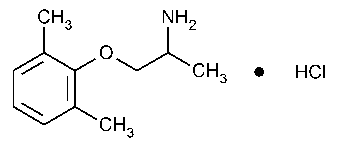Mexiletine Hydrochloride
2-Propanamine,1-(2,6-dimethylphenoxy)-,hydrochloride,(±)-.
(±)-1-Methyl-2-(2,6-xylyloxy)ethylamine hydrochloride [5370-01-04].
»Mexiletine Hydrochloride contains not less than 98.0percent and not more than 102.0percent of C11H17NO·HCl,calculated on the dried basis.
Packaging and storage—
Preserve in tight containers.
Identification—
A:
Infrared Absorption á197Mñ.
B:
Prepare a test solution by dissolving a suitable quantity of it in methanol to obtain a concentration of about 10mg per mL.Similarly prepare a Standard solution,using USP Mexiletine Hydrochloride RS.Separately apply 5-µLportions of the test solution and the Standard solution to a suitable thin-layer chromatographic plate (see Chromatography á621ñ)coated with a 0.25-mm layer of chromatographic silica gel.Develop the chromatogram in a suitable chromatographic chamber half saturated with solvent vapor,using a solvent system consisting of a mixture of chloroform,methanol,and ammonium hydroxide (425:70:5)until the solvent front has moved about three-fourths of the length of the plate.Remove the plate from the developing chamber,mark the solvent front,and allow the solvent to evaporate.Spray the plate with a 1in 500solution of fast blue BBsalt in methanol,and dry the plate at 105 for 15minutes.Locate the spots on the plate by spraying it with a 1in 5solution of potassium hydroxide in methanol:the RFvalue of the principal spot obtained from the test solution corresponds to that obtained from the Standard solution.
for 15minutes.Locate the spots on the plate by spraying it with a 1in 5solution of potassium hydroxide in methanol:the RFvalue of the principal spot obtained from the test solution corresponds to that obtained from the Standard solution.
C:
To 3mLof a solution (1in 60)add 1mLof 6Nammonium hydroxide,filter,and acidify the filtrate with 2mLof nitric acid.Then add 1mLof silver nitrate TS:a curdy,white precipitate is formed,and it is soluble in an excess of 6Nammonium hydroxide (presence of chloride).
pHá791ñ:
between 3.5and 5.5,in a solution (1in 10).
Loss on drying á731ñ—
Dry it at 105 for 2hours:it loses not more than 0.5%of its weight.
for 2hours:it loses not more than 0.5%of its weight.
Residue on ignition á281ñ:
not more than 0.1%.
Heavy metals,Method IIá231ñ:
0.001%.
Chromatographic purity—
Standard solution—
Transfer 10.0mLof the Standard preparationprepared as directed in the Assayto a 100-mLvolumetric flask,dilute with Mobile phaseto volume,and mix.This solution contains about 0.2mg of USP Mexiletine Hydrochloride RSper mL.
Test solution—
Transfer about 100mg of Mexiletine Hydrochloride,accurately weighed,to a 5-mLvolumetric flask,dilute with Mobile phaseto volume,and mix.
Chromatographic system (see Chromatography á621ñ)—
Prepare as directed in the Assay,except that the relative standard deviation for replicate injections of the Standard solutionis not more than 3.0%.
Procedure—
Proceed as directed for Procedurein the Assay.Calculate the percentage of each impurity observed taken by the formula:
500(C/W)(rU/rS),
in which Cis the concentration,in mg per mL,of USP Mexiletine Hydrochloride RSin the Standard solution,Wis the weight,in mg,of the Mexiletine Hydrochloride taken to prepare the Test solution,rUis the peak response obtained from an individual impurity observed in the chromatogram of the Test solution,and rSis the mexiletine peak response obtained from the Standard solution:not more than 1%of any individual impurity is found,and the total of all observed impurities is not more than 1.5%.
Organic volatile impurities,Method Iá467ñ:
meets the requirements.
Assay—
Sodium acetate buffer solution—
Dissolve 11.5g of anhydrous sodium acetate in 500mLof water,add 3.2mLof glacial acetic acid,mix,and allow to cool.Adjust with hydrochloric acid to a pHof 4.8±0.1,dilute with water to 1000mL,and mix.
Mobile phase—
Prepare a suitable filtered and degassed mixture of methanol and Sodium acetate buffer solution(600:400).Make adjustments if necessary (see System Suitabilityunder Chromatography á621ñ).
Standard preparation—
Dissolve an accurately weighed quantity of USP Mexiletine Hydrochloride RSin Mobile phaseto obtain a solution having a known concentration of about 2mg per mL.
Resolution solution—
Prepare a solution of 2-phenylethylamine hydrochloride in Standard preparationcontaining about 1mg per mL.
Assay preparation—
Transfer about 100mg of Mexiletine Hydrochloride,accurately weighed,to a 50-mLvolumetric flask,dissolve in and dilute with Mobile phaseto volume,and mix.
Chromatographic system
(see Chromatography á621ñ)—The liquid chromatograph is equipped with a 254-nm detector,a guard column containing packing L1,and a 3.9-mm ×30-cm column that contains 10-µm packing L1.The flow rate is about 1mLper minute.Chromatograph about 20µLof the Resolution solution,and record the peak responses as directed under Procedure:the resolution,R,between the 2-phenylethylamine and mexiletine peaks is not less than 3.0.Chromatograph the Standard preparation,and record the peak responses as directed under Procedure:the relative standard deviation for replicate injections is not more than 2.0%.
Procedure—
[NOTE—Use peak areas where peak responses are indicated.]Separately inject equal volumes (about 20µL)of the Assay preparationand the Standard preparationinto the chromatograph,record the chromatograms,and measure the responses for the major peaks.The relative retention times are about 0.7for 2-phenylethylamine and 1.0for mexiletine.Calculate the quantity,in mg,of C11H17NO·HCl in the portion of Mexiletine Hydrochloride taken by the formula:
50C(rU/rS),
in which Cis the concentration,in mg per mL,of USP Mexiletine Hydrochloride RSin the Standard preparation,and rUand rSare the mexiletine peak responses obtained from the Assay preparationand the Standard preparation,respectively.
Auxiliary Information—
Staff Liaison:Andrzej Wilk,Ph.D.,Senior Scientific Associate
Expert Committee:(PA5)Pharmaceutical Analysis 5
USP28–NF23Page 1290
Phone Number:1-301-816-8305
